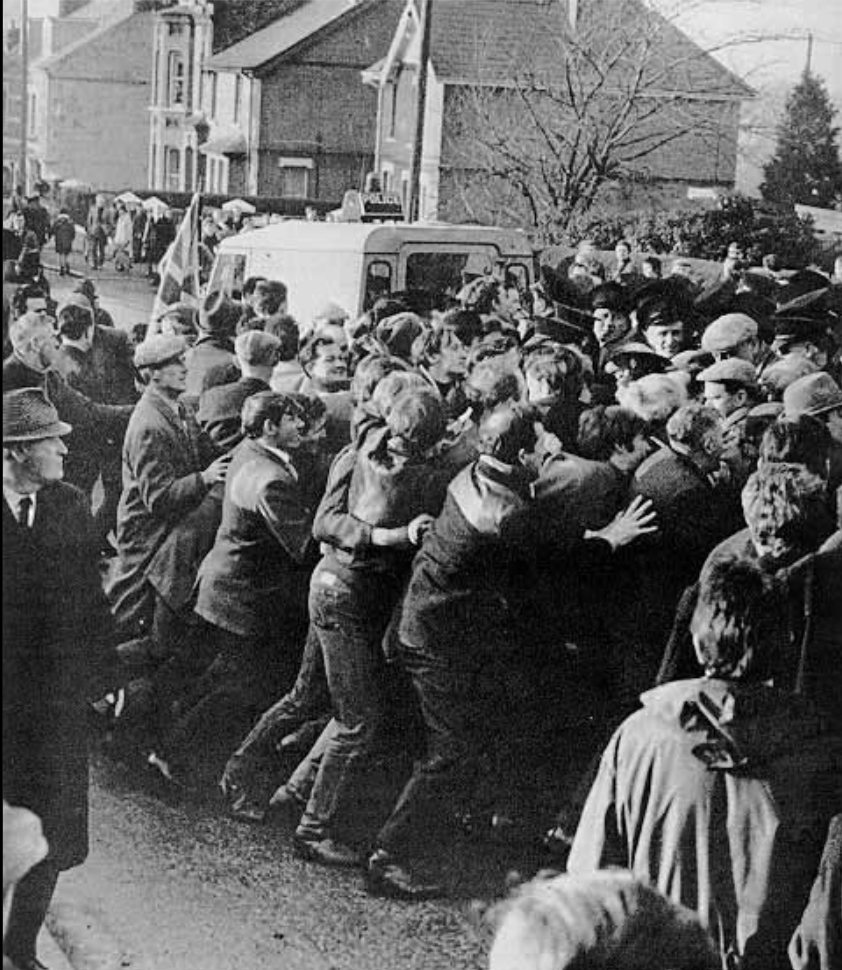Written by James McFadden
The attack of Civil Rights demonstrators at Burntollet Bridge was a major starting point for civil unrest during The Troubles. The event had started on the morning of January 1st outside Belfast City Hall, organized by students to hold a long protest march from Belfast to Derry. They were protesting for a variety of reasons such as equal voting rights, improved public housing, and in order to fight Northern Irish laws that restricted individual freedoms. In short, the 4-day march was meant to protest for Civil Rights, inspired by the new form of peaceful protest that was garnering worldwide attention in the American south. The entire procession of the march was one long ordeal characterized by harassment and cooperation between police and civilians to deter the protestors until things finally came to a head at Burntollet Bridge. The protest attempted to recreate what had been achieved in other parts of the world, but sadly failed to yield productive results in terms of peace.
The 1960s saw radical changes for the advancement of people’s human rights the world over, and many of the events of the era inspired change for decades to come and still have an impact today. The decade saw drastic social advancement as well as attempts to suppress the rights of citizens, from Alabama to the Eastern Bloc of the Soviet Union. This era also saw ideas such as peaceful protest and civil disobedience take hold as a viable and legitimate way to achieve social justice. The most famous example that relates to the Burntollet Bridge incident would have to be the march from the City of Selma to Montgomery in Alabama in 1965. Organized by Nobel Peace Prize winner Martin Luther King Jr. the march was intended to protest the suppression of African Americans from registering to vote in the wake of the Civil Rights Act. Much like the Belfast to Derry march, the protestors were viciously attacked by police and citizens alike, only reaching their goal to make it to Montgomery after the U.S. Army and National Guard stepped in to protect them. The famous March was publicly reported all over the world, resulted in the Voting rights act of 1965 and became a true success story for what peaceful protest could achieve. This great success of peaceful protest was an inspiration around the world, and must have been especially thrilling for Catholic students in Northern Ireland who hoped to bring change to their corner of the world. They carried on for three days through Northern Ireland, being harassed the entire way, unprotected by the Constabulary. Finally, on the fourth and final day, they were ambushed by a large crowd of loyalists who were allowed to do as they pleased by the police. The marchers were beaten and hit with volleys of stones thrown from a ridge above the bridge. “Then the bombardment really started. Bottles, bricks and stones rained down. One marcher noted: “I am not speaking of chips or pebbles. These were quarried stones, some of them several pounds in weight.” (cain.ulster.ac.uk). About 100 people were injured as a direct result of the ambush and it promptly stopped the marchers push into Derry. It is unfortunate that there was no intervention to help them reach their goal and the events that unfolded ultimately created more tensions than they relieved.


Although the March from Belfast to Derry was meant to champion Civil rights in a peaceful manner, it more likely acted to convince many Catholics that peaceful struggle would not be possible in Northern Ireland. The ruthless ambush that was conducted at Burntollet Bridge had illustrated that the right to peaceful protest was not going to be protected. Quite the opposite, it showed the proponents of civil rights that police agencies were actively involved in collusion to suppress such demonstrations. After the events at Burntollet, the year 1969 saw an increase in sectarian violence, an escalation of tensions between Catholics and Protestants and a loss of trust of State Authority for Catholics. The ambush at Burntollet did much to reinforce the mental borders and boundaries in terms of the boundary of being second class citizens who are to be beaten, not protected. It also reinforced this notion physically, in terms of literally being stopped from going where you want to go and turned around as if there was a wall of Protestantism barring your entry. Throughout the year, the distrust of police had become evident from riots in Northern cities, and boiled over at The Battle of the Bogside. Hopeful students like the Price sisters became disillusioned in their peaceful fight for justice, and groups like the IRA again rose to prominence amongst the violence. The events of January 1st through the 4th of 1969 was the first major instance of violence leading up to The Troubles which greatly helped to reinforce sectarian divisions and essentially ruin the possibility of a peaceful solution being reached for several decades.
Works Cited
Melaugh, Dr Martin. “Events: People’s Democracy March: Egan, Bowes. and McCormack, Vincent. ‘Burntollet’.” CAIN. 1969. Web. 08 Dec. 2020.
Melaugh, Dr Martin. “Events: People’s Democracy March: Egan, Bowes. and McCormack, Vincent. ‘Burntollet’.” Web. 08 Dec. 2020.
Posted by Cuthbert Telesford | Global Black Caucus Steering Team Secretary March 25, 2018. “Selma to Montgomery Marches on March 7 – 25, 1965.” Democrats Abroad. Web. 08 Dec. 2020.
A Film Clip from the Belfast to Derry ‘Long March’ in January 1969. 5 Jan. 2019, http://www.youtube.com/watch?v=miKji5ShMec.